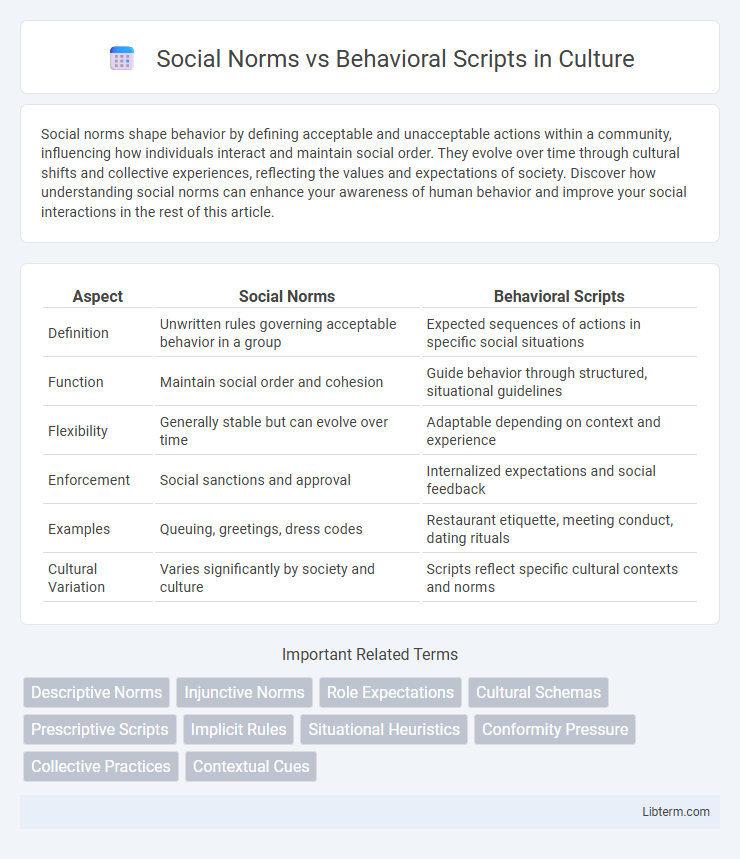Social norms shape behavior by defining acceptable and unacceptable actions within a community, influencing how individuals interact and maintain social order. They evolve over time through cultural shifts and collective experiences, reflecting the values and expectations of society. Discover how understanding social norms can enhance your awareness of human behavior and improve your social interactions in the rest of this article.
Table of Comparison
| Aspect | Social Norms | Behavioral Scripts |
|---|---|---|
| Definition | Unwritten rules governing acceptable behavior in a group | Expected sequences of actions in specific social situations |
| Function | Maintain social order and cohesion | Guide behavior through structured, situational guidelines |
| Flexibility | Generally stable but can evolve over time | Adaptable depending on context and experience |
| Enforcement | Social sanctions and approval | Internalized expectations and social feedback |
| Examples | Queuing, greetings, dress codes | Restaurant etiquette, meeting conduct, dating rituals |
| Cultural Variation | Varies significantly by society and culture | Scripts reflect specific cultural contexts and norms |
Understanding Social Norms: Definition and Examples
Social norms are shared expectations and rules guiding behavior within a group, influencing actions by establishing what is considered acceptable or unacceptable. Examples include queuing in a line, dressing appropriately for specific occasions, and maintaining eye contact during conversations. These unwritten rules facilitate social order and predictability, shaping interactions across cultures and communities.
What Are Behavioral Scripts? Key Concepts
Behavioral scripts are cognitive frameworks that guide individuals on how to act in specific social situations by outlining expected sequences of behavior. These scripts help people anticipate others' actions and reduce uncertainty during interactions by providing structured, context-dependent behavioral patterns. Key concepts include the role of situational cues, the automatic activation of scripts, and their influence on social conformity and predictability.
Social Norms vs Behavioral Scripts: Core Differences
Social norms represent collective expectations and unwritten rules that govern group behavior, guiding what is considered acceptable or unacceptable in various social contexts. Behavioral scripts are structured sequences of actions individuals follow in specific situations, providing a mental framework for routine interactions. The core difference lies in social norms shaping overall societal values and appropriate conduct, while behavioral scripts offer detailed guidelines for executing behavior in particular scenarios.
The Origins of Social Norms and Behavioral Scripts
Social norms originate from collective cultural values and shared expectations within communities, guiding acceptable behavior to maintain social order and cohesion. Behavioral scripts develop from repeated social interactions and situational experiences, enabling individuals to predict and enact appropriate responses in familiar contexts. Both emerge through social learning processes, where observation, imitation, and reinforcement shape individuals' understanding of acceptable conduct.
How Social Norms Influence Daily Behavior
Social norms shape daily behavior by establishing shared expectations within groups, guiding actions through implicit rules about what is acceptable or taboo. These unwritten social codes influence decisions, motivating conformity to gain social approval or avoid sanctions, thus regulating interactions in public spaces, workplaces, and family settings. Behavioral scripts, by contrast, represent learned sequences of actions for specific situations, but social norms fundamentally underpin these scripts by setting the broader cultural context for appropriate conduct.
The Role of Behavioral Scripts in Social Interactions
Behavioral scripts function as cognitive frameworks guiding individuals through expected sequences of actions in social interactions, ensuring predictability and coherence. These scripts shape how people interpret social cues, respond to others, and navigate complex social environments by providing a mental blueprint for appropriate behavior. By automating responses, behavioral scripts reduce cognitive load and facilitate smoother communication within various social contexts.
Real-Life Scenarios: Social Norms vs Behavioral Scripts
Social norms guide acceptable behavior in various real-life scenarios, such as standing in line or greeting others, by establishing shared expectations within a community. Behavioral scripts provide detailed sequences of actions for specific situations, like attending a job interview or dining at a restaurant, enabling individuals to navigate social interactions smoothly. Understanding the distinction helps individuals adapt to social contexts by recognizing both the general rules and the expected procedural behaviors.
Cultural Variations in Norms and Scripts
Social norms and behavioral scripts vary significantly across cultures, shaping individuals' actions and expectations in diverse social contexts. For example, individualistic cultures like the United States emphasize personal autonomy and direct communication norms, whereas collectivist cultures such as Japan prioritize group harmony and indirect communication scripts. These cultural variations influence how social roles are enacted and how deviations from norms are perceived, highlighting the importance of context in understanding social behavior globally.
Breaking Social Norms and Altering Behavioral Scripts
Breaking social norms involves deviating from shared, unwritten rules that guide acceptable behavior within a community, often triggering social sanctions or changing perceptions. Altering behavioral scripts requires modifying the habitual sequences of actions people follow in specific contexts, enabling flexibility and adaptation in social interactions. Both processes are crucial for social innovation and cultural evolution, as they challenge established patterns and encourage new ways of thinking and behaving.
The Impact of Social Norms and Behavioral Scripts on Society
Social norms shape acceptable behaviors by establishing collective expectations that guide individuals within a society, promoting social cohesion and reducing conflicts. Behavioral scripts provide predefined sequences of actions for specific situations, helping individuals navigate social interactions efficiently and predictably. Together, these frameworks influence societal order, decision-making, and cultural continuity by reinforcing conformity and facilitating coordinated behavior.
Social Norms Infographic

 libterm.com
libterm.com